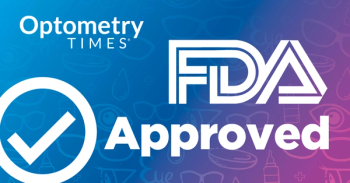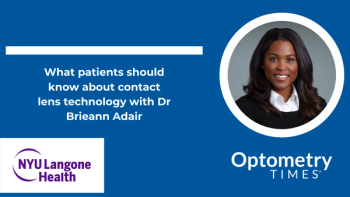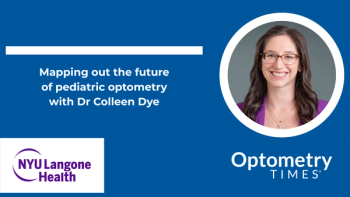
- Optometry Times October 2019
- Volume 11
- Issue 10
Nutrition in the future of primary-care optometry
While the science of nutrition has been evolving for years, its role in patient care has long remained elusive. Understanding the importance of food intake can have clinical implications for the modern practice of optometry and medicine.
The 21st-century movement toward patient-driven health care is driving the use of mobile health applications (apps), artificial intelligence (AI), and wearable technologies.
ODs are integral to the care of chronic diseases like
Furthermore, optometric practices that develop expertise in
Previously by Dr. Wong: Is optometry ready for the age of smartphone imaging?
Benefits of apps/tech
Mobile apps and technology empower consumers with information to be more proactive in monitoring their own health.
One example includes the low FODMAP (fermentable oligosaccharide disaccharide monosaccharide and polyols) app from Monash University, which makes consumers more conscientious and self-aware of their behavior.1
Proper awareness supports action, encourages positive health behavior and preventive measures (including the MyFitnessPal and Nike Training Club apps), and helps guide consumers to a better assessment and decision-making with particular health situations (MyGiHealth GI Symptom Tracker App).2-4
Platforms for monitoring wellness include:
Activity/exercise logs
Nutrition and caloric intake
Amount and quality of sleep
Personalized food recommendations
Related:
Fitness and optometry
Optometrists in sports vision have taught the importance of advances in performance technology.
Additionally, the use of integrated mobile health technology and wearable AI technology is growing exponentially.6
Elite athletes in sports such as tennis, baseball, basketball, and soccer train and recover with the aid of new technologies, improved diets, and proper sleep patterns.
ODs are finding lessons that can be translated to all patients who want to live longer, healthier, and more active lives. Smart watches, Fitbits, and other monitoring devices are technologies ODs should understand to better educate and care for patients.7
Related:
Food as medicine
“Food as medicine” is a growing movement redefining views on the science of nutrition and medicine’s role in using dietary recommendations to manage chronic health conditions like diabetes, HTN, Crohn’s disease, colitis, irritable bowel syndrome (IBS), and small intestinal bacterial overgrowth (SIBO) syndrome.8
Healthcare systems-such as Mount Sinai in New York City-are investing and partnering with healthcare companies like Epicured, a subscription meal delivery service specializing in low FODMAP and gluten-free prepared foods.9
In 2017, Mount Sinai’s Division of Gastroenterology performed a clinical review of Epicured’s food product. It has since provided food services to deliver low FODMAP meals to the healthcare system’s patients.9
A low FODMAP diets consist of meals without garlic, onions, milk, apples, and up to 10 mg of celery.
While there are other restrictions, the diet is 70 percent effective in reducing IBS.10Related:
What to recommend to patients
Patients often ask questions of their eyecare practitioners about the relationship between nutrition and eye health. Although the age-related eye disease study (AREDS) and role of antioxidants in the management of patients with AMD is well documented, more evidence-based studies with clinical applications to the art and science of optometry are needed.11
In relation to general eye health questions, both the National Eye Institute (NEI) and American Optometric Association (AOA) have long offered educational resources.
Two of the four recommendations by the NEI to keep your eyes healthy are:12
Eat right to protect eye sight
Eating a diet rich in fruits and vegetables, particularly dark leafy greens such as spinach, kale, or collard greens, is also important for keeping eyes healthy. Research has also shown there are eye health benefits from eating fish high in omega-3 fatty acids, such as salmon, tuna, and halibut.
Related:
Maintain a healthy weight
Being overweight or obese increases the risk of developing
The AOA has a webpage on diet and nutrition with recommendations to add antioxidants and nutrients to diets under certain conditions.13
The AOA also provides pamphlets and other educational materials educating ODs and the public about the eye and nutrition.
Organizations providing information on the importance of nutrition in eye health include the American Diabetes Association (ADA), American Public Health Association (APHA), and the Ocular Wellness and Nutrition Society (OWNS).14-16
OWNS provides informational and educational resources to healthcare professionals, the public, and the media on the relationship between nutrition and ocular health.
Related:
Nutrition and chronic disease
A healthy diet and lifestyle promotes the prevention and reversal of chronic diseases.
Seven out of the 10 leading causes of death are directly related to dietary choices:17
Heart disease
Cancer
Lung disease
Cerebrovascular disease (CVD)
Alzheimer’s disease
Kidney disease
Eighty percent of chronic disease can be prevented with simple lifestyle habits and putting nutrition at the top of the list.18
CVD
Red and processed meat consumption are associated with an increased CV risk; those following a vegetarian diet have a decreased risk of mortality19
Fruits and vegetables lead to CV risk reduction
Processed meat consumption is linked to an increased risk of
Eating whole grains and fruit decreases risk of diabetes mellitus (DM), micro-, and macro-vascular complications
Hyperglycemia impairs the regulation of
Cancer
Red meat increases risk of colorectal cancer21
Whole grains, fruits, and vegetables are associated with a significant reduction in total cancer risk
Chronic eye disease
Dietary antioxidants and anti-inflammatories help decrease the risk of age-related eye disease and help deter the progression of other chronic eye diseases.22
Omega-3 rich diets result in neuroprotective effects, help with tear osmolarity, improve tear quality, and reduce meibomian gland dysfunction (MGD).23
Related:
Examples of omega- 3 fatty acids in food include:
Fish and shellfish (mackerel, salmon, cod liver oil, herring, oysters, sardines, anchovies, caviar)
Seeds (flaxseeds, chia seeds)
Nuts (walnuts)
Related:
AMDCarotenoids: Certain antioxidants-carotenoids-reduce the effect of free radicals on the macular pigment and help with retinal pigment layer thickening. A diet high in carotenoids can also delay the advancement of AMD.24
Beta carotene: Carrots, sweet potato, dark leafy greens, red and yellow peppers.
Lutein: Dark, leafy veggies (spinach, collard greens, kale).
Zeaxanthin: Dark, leafy veggies (spinach, collard green, kale).
Vitamin C: Kiwi, citrus fruits, mango, papaya (also helps prevent cataracts)
Vitamin E: Vegetable oils, nuts, green vegetables. Should be taken in combination with other vitamins and minerals listed here; taken alone not beneficial for AMD.25
Zinc: Brings Vitamin A from liver to retina to produce melanin (meat, shellfish, legumes, eggs, whole grains, seeds).
Copper: Nuts, seeds, leafy greens, oysters, organ meats.
Related:
Patient education
Using diet to address underlying chronic disease can help with the management of chronic eye diseases and improve patient health outcomes.
Diabetic retinopathy/cataracts/ glaucoma
Recommend a diabetic diet to manage blood sugar and minimize microvascular damage, such as dietary fiber, oily fish, a Mediterranean diet, and a reduced caloric intake; they are associated with lower risk of
Patients at risk for HTN retinopathy
Manage with a low-sodium diet to help decrease HTN retinopathy, pressure on blood vessels, retinal edema, and swelling of the optic nerve.27
Future of food
What is the future role of optometry in altering the
The rapid rise of
Read more technology articles here
References:
1. Monash University. Your complete on-the-go guide to the FODMAP Diet. Available at: https://www.monashfodmap.com/ibs-central/i-have-ibs/get-the-app/. Accessed 9/11/19.
2. My FitnessPal. Lose Weight with MyFitnessPal.com-for FREE! Available at:
3. Nike. Nike Training Club App. Available at:
4. Apple. My GiHealth GI Symptom Tracker. Available at:
5. American Optometric Association. Sports & Performance Vision. Available at:
6. Mischke J. The State of Wearable Technology in Healthcare: Current and Future. Wearable Technologies. Available at:
7. Wearable Technologies. Wearable Technologies Show 2019 MEDICA. Available at:
8. Food is Medicine Coalition. The Medically Tailored Meal Intervention. Available at:
9. Mount Sinai. Mount Sinai Health System and Epicured Partner to Bring Culinary Cures to Patients. Available at:
10. Stanford Health Care. Low FODMAP Diet: Our Approach to the Low FODMAP Diet. Available at:
11. National Eye Institute. What the Age-Related Eye Disease Studies Mean for You. Available at:
12. National Eye Institute. Healthy Eyes. Available at:
13. American Optometric Association. Diet & Nutrition. Available at:
14. American Diabetes Association. Nutrition: Eating doesn’t have to be boring. Available at:
15. American Public Health Association. Food and Nutrition. Available at:
16. Ocular Wellness and Nutrition Society. Mission Statement. Available at:
17. Centers for Disease Control and Prevention (CDC). National Center for Chronic Disease Prevention and Health Promotion (NCCDPHP): Chronic Disease in America. Available at:
18. World Health Organization (WHO). Chronic disease and health promotion: Overview-Preventing chronic diseases: a vital investment. Available at:
19. Physicians Committee for Responsible Medicine. Red Meat Increases Heart Disease Risk. Available at:
20. Grunwald JE, Brucker AJ, Schwartz SS. Braunstein SN, Baker L, Petrig BL, Riva CE. Diabetic glycemic control and retinal blood flow. Diabetes. 1990 May;39(5):602-7.
21. Aykan NF. Red Meat and Colorectal Cancer. Oncol Rev. 2015 Feb 10; 9(1):288.
22. Rasmussen HM, Johnson EJ. Nutrients for the aging eye. Clin Interv Aging. 2013 Jun;8: 741-748.
23. Faulkner WJ. The Role of Omega-3 Essential Fatty Acids in Dry Eye Disease. Int J Clin Exp Ophthalmol. 2017 Dec 22;1:055-059.
24. American Optometric Association. Nutrition and Age-Related Macular Degeneration. Available at:
25. Harvard T.H. Chan School of Public Health. The Nutrition Source: Vitamin E. Available at:
26. Wong MYZ, Man REK, Fenwick EK, Gupta P, Ling-Jun L, van Dam RM, Chong MF, Lamoureux EL. Dietary intake and diabetic retinopathy: A systematic review. PLoS One. 2018;13(1): e0186582.
27. Harvard Health Publishing. Retinopathy. Available at:
Articles in this issue
about 6 years ago
Lyme disease: The 45-year silent epidemicabout 6 years ago
Epi-on cross-linking may speed visual recoveryabout 6 years ago
30 years of LASIKabout 6 years ago
More than a yellow lesion?about 6 years ago
Go beyond medical treatment for recurrent corneal erosionabout 6 years ago
Toxoplasmosis shows varied diagnosisabout 6 years ago
Artificial intelligence might be the future of practice managementabout 6 years ago
Why taking patient history never endsabout 6 years ago
Dry eye signs may signal risk for diabetic foot ulcersabout 6 years ago
Q&A: Academia, contact lenses, beer, climbing a water towerNewsletter
Want more insights like this? Subscribe to Optometry Times and get clinical pearls and practice tips delivered straight to your inbox.



















































.png)


